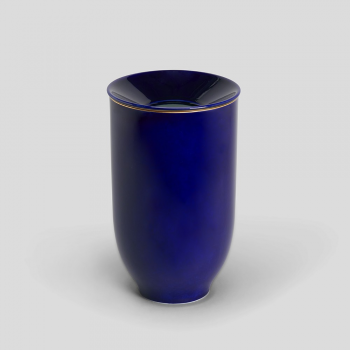A Royal Manufactory
In 1740, under the reign of Louis XV and the influence of Madame de Pompadour, the king's favourite, a soft-paste porcelain workshop was founded in Vincennes in a tower of the royal castle.
In 1756, the manufactory was transferred to Sèvres in a building built on the initiative of Madame de Pompadour, near her Bellevue castle. It was built between 1753 and 1756 by the architect Laurent Lindet on the site of the farm known as "de la Guyarde". Today, this building houses a national education department.
In 1759, Louis XV allowed the Manufacture de Sèvres to have a greater influence in Europe by placing it under the full control of the Crown. From the very beginning, the Manufacture found a loyal client and patron in Madame de Pompadour.

Portrait of the Marquise de Pompadour by Boucher, 1756
In 1768, two researchers at the Manufactory, Pierre-Joseph Macquer and Robert Millot, discovered the first French deposit of kaolin near Limoges. This brand new hard paste was systematically adopted for sculpture at Sèvres.
From 1800 to 1847, the Manufacture de Sèvres was managed by the scholar Alexandre Brongniart, son of the architect of the Bourse de Paris, who ensured its exceptional development.
The 19th century: between tradition and innovation
In 1861, the architect Jacques Felix Alexandre Laudin began building new production workshops and a museum on a plot of land on the Saint-Cloud estate.

Engraving representing the Manufacture de Sèvres in 1869
In 1867, the Neptune vase was produced for the Universal Exhibition. It was a real challenge for the Manufacture de Sèvres as it was the largest vase ever made up to that time. It is exceptional and unique because of its monumental size of 3.15 metres in height and 1.17 metres in diameter, and because of its weight of more than one tonne of hard porcelain, marble for the base and bronze for the inner structure.

Postcard showing the Neptune Vase in the Grand Salon of the Musée de Sèvres
In 1875, a "new paste" of porcelain was developed, more similar to Chinese porcelain. New colours were developed. In 1875, Albert-Ernest Carrier-Belleuse was appointed director of the works of art at the Manufacture de Sèvres.
He creates a complete range of vases. The new shapes imagined by the sculptor, such as the Saigon vase and the Mycenae vase, were very successful at the 1884 Central Union of Decorative Arts exhibitions.

Postcard showing the Neptune Vase in the Grand Salon of the Musée de Sèvres
In 1876, six Minton-type furnaces were built in the factory. These were two-part furnaces, two of which are still in use in the workshops today.

Construction of a Minton kiln and chimney
The Manufacture de Sèvres, a true showcase of the French way of life and the embodiment of excellence in arts and crafts, receives many distinguished visitors during state visits, such as the visit of Tsar Alexander II of Russia and his wife Alexandra on 8 October 1896.

Visit of Tsar Nicholas II and his wife Alexandra to the Manufacture de Sèvres, 8 October 1896
Sèvres and the great exhibitions of the 20th century
Between 1900 and 1937, the Manufacture's activity revolved around the major universal and international exhibitions such as the Paris Universal Exhibition in 1900, the International Exhibition of Decorative Arts in 1925 and the International Exhibition of Arts and Techniques in 1937.

Pavilion of the Manufacture de Sèvres, 1937
Sèvres during the two wars
During the First World War, the Sèvres Manufactory improvised and adapted by producing the stoneware materials needed to manufacture gunpowder for firearms. A railroad was specially built in the factory to facilitate the logistics of the parts.
"It is very good that, during the war, Sèvres renders services instead of making them", wrote Le Figaro on 20 August 1916.

Sèvres transformed into an armaments factory, 1916

Railway line crossing the Manufacture de Sèvres, 1916
On 3 March 1942, the Museum and the Manufacture de Sèvres were bombed by British army planes. The attack was intended to disable the Renault factory on the Ile Seguin, next to the Pont de Sèvres. At least seven bombs exploded all around the Museum, blowing out the windows and most of the display cases in the exhibition rooms.
An entire wing of the Museum is destroyed. Further bombings took place in the following years, in 1943 and 1944.
Sèvres today, at the heart of artistic research
Porcelain production is in tune with the most contemporary creation of the 21st century.
Since its beginnings, the greatest names in art such as Boucher, Duplessis, Falconet in the 18th century, Carrier-Belleuse, Rodin in the 19th century, Ruhlmann in the 1930s, Mayodon, Calder, Poliakoff in the 1950s, and more recently Zao Wou-ki, Louise Bourgeois, Ettore Sottsass, Pierre Soulages, Pierre Charpin, have enriched the repertoire of forms and decorations at Sèvres.

A painters' workshop at the Manufacture de Sèvres, 1950

The moulding-repair workshop
In 1986, the Manufacture became a member of the Comité Colbert, which groups together French luxury companies.


The workshop of the grand coulage then and now



